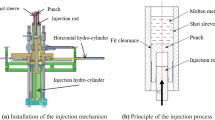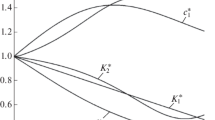Abstract
The robustness and noise warranty costs of many automotive friction materials like transmission belts or brake pad are directly affected by the frictional properties in cold start-up running. This paper presents a friction model for start-up running under cold conditions. The absorbed water, phase changes and variable lubrication regimes in cold start-up running are taken into account. The model includes the breakage of ice adhesion, ice–ice friction between the ice films on friction pairs, melting water-mediated mixed lubrication and boundary lubrication, friction elevation due to capillary adhesive effect, as well as dry contact in the end of cold start-up running. Thermal analysis is applied in conjunction with the friction model to estimate the parameters in phase transitions. A meniscus model is also integrated into the friction model to address the friction elevation due to the variation of water film thickness. It is illustrated that if the thickness of surface ice film is larger than a critical value, the static friction coefficient could be close to 1; if the thickness of melting water film is higher than the average roughness of the surface, static friction could increase due to capillary effect, and kinetic friction could decrease due to mixed lubrication resulting in wide modulation of friction during intermittent start-up transitions. This paper also presents the application of the model to elucidate the friction mechanisms in cold brake noise where the cold wet coefficient of friction (cof) could be substantially higher than the dry cof. The effects of temperature, roughness and load on cof are also characterized.









Similar content being viewed by others
Abbreviations
- B:
-
Width of brake pad
- \( c_{p} \) :
-
Specific heat
- E:
-
Young’s modulus of brake pad
- \( F_{d} \) :
-
Friction contributed by asperity contact
- \( F_{f} \) :
-
Total friction in mixed lubrication
- \( F_{l} \) :
-
Friction contributed by water hydrodynamic regions
- \( F_{m} \) :
-
Meniscus force
- \( h \) :
-
Adsorption thickness on surface
- \( k \) :
-
Thermal diffusivity
- k 1, k 2 :
-
Thermal conductivity of component 1 and component 2, respectively
- L :
-
Length of brake pad
- \( L_{0} \) :
-
Sintering factor for ice friction
- N :
-
Density of asperity peaks
- \( Q \) :
-
Heat flux due to frictional heating
- \( p_{i} \) :
-
Applied pressure on brake pad
- p m :
-
Maximum Hertzian pressure
- RH :
-
Relative humidity
- R i , R o :
-
Inner and outer radii of the disk engaging pad
- T :
-
Temperature rise
- T 0 :
-
Initial temperature
- t :
-
Thickness of pad
- v :
-
Velocity
- \( V_{l} \) :
-
Molar volume of the water
- \( \alpha \) :
-
Water-pad contact angle
- \( \beta \) :
-
Radius of asperity peaks
- \( \sigma_{r} \) :
-
RMS of brake pad roughness
- \( \gamma \) :
-
Surface tension of water at 20 °C
- \( \eta_{50} \) :
-
Dynamic viscosity at 50 °C
- \( \eta_{30} \) :
-
Dynamic viscosity at 30 °C
- \( \eta_{10} \) :
-
Dynamic viscosity at 10 °C
- \( \eta_{2} \) :
-
Dynamic viscosity at 2 °C
- \( \rho_{Pad} \) :
-
Pad density
- \( \mu \) :
-
Coefficient of friction
- \( \mu_{s} \) :
-
Static friction coefficient
- \( \sigma \) :
-
Compressive yield strength of ice
- \( \tau \) :
-
Critical shear stresses or strengths of interfacial layer
- \( \alpha_{1} \) :
-
Thermal diffusivity of component 1
- \( \rho \) :
-
Mass density
- \( \sigma_{r} \) :
-
RMS of roughness
- \( \beta \) :
-
Radius of asperity peaks
- \( \phi (z) \) :
-
Gaussian distribution of peak heights
- \( \gamma \) :
-
Surface tension of water
- r k :
-
Kelvin radius
References
Alexandre C (2007) Three-dimensional model for capillary nanobridges and capillary forces. Modelling Simul Mater Sci Eng 15:305–317
Al-Samieh M, Rahnejat H (2001) Ultra-thin lubricating films under transient conditions. J Phys D 34:2610–2621
Baurlea L, Szabo D, Fauvea M, Rhyner H, Spencer ND (2006) Sliding friction of polyethylene on ice: tribometer measurements. Tribol Lett 24:77–84
Bergman F, Eriksson M, Jacobson S (1999) Influence of disc topography on generation of brake squeal. Wear 225–229:621–628
Bhushan B, Kotwal CA (1998) Kinetic meniscus model for prediction of rest stiction. ASME Trans Tribol 42:120
Bowden FP (1953) Friction on snow and ice, proceedings of the royal society of London. Ser A Math Phys Sci 217:462–478
Brecht J, Schiffner K (2001) Influence of friction law on brake creep-groan, SAE Technical Papers Series 2001-01-3138
Briscoe WH, Titmuss S, Tiberg F, Thomas RK, McGillivray DJ, Klein J (2006) Boundary lubrication under water. Nature 444:191–194
Buhl D, Fauve M, Rhyner H (2001) The kinetic friction of polyethylene on snow: the influence of the snow temperature and the load. Cold Reg Sci Technol 33:133–140
Cai S, Bhushan B (2007) Meniscus and viscous forces during normal separation of liquid-mediated contacts. Nanotechnology 18:465704
Cameron L (1976) Basic lubrication theory. Wiley, New York
Chen F (2006) Break Squeal. SAE International Publisher, Warrendale
Dennis BP (2004) Industrial vehicle technology international 24–26
Despond S, Espuche E, Domard A (2001) Water sorption and permeation in Chitosan films: relation between gas permeability and relative humidity. J Polym Sci Part B Polym Phys 39:3114–3127
Ducreta S, Zahouania H, Midol A, Lanterib P, Mathiaa TG (2005) Friction and abrasive wear of UHWMPE sliding on ice. Wear 258:26–31
Eriksson M, Bergman F, Jacobson S (1999) Surface characterization of brake pads after running under silent and squealing conditions. Wear 232:163–167
Eriksson M, Bergman F, Jacobson S (2002) On the nature of tribological contact in automotive brakes. Wear 252:26–36
Faraon C, Schipper DJ (2007) Stribeck curve for starved line contacts. J Tribol 129:181–187
Gelinck ERM, Schipper DJ (2000) Calculation of Stribeck curves for line contacts. Tribol Int 33:175–181
Greenwood JA, Tripp JH (1970) The contact of two nominally flat surfaces. Proc Instn Mech Engrs, 185:625–633
Herrebrugh K (1968) Solving the incompressible and Es elasticity number, dimensionless isothermal problem in elastohydrodynamics Fw load parameter, dimensionless through an integral equation. ASME J Lubric Technol 90:262
Jinesh KB, Frenken JWM (2006) Capillary condensation in atomic scale friction: How water acts like a glue? Phys Rev Lett 96:166103
Jung YC, Bhushan B (2006) Contact angle, adhesion and friction properties of micro- and nanopatterned polymers for superhydrophobicity. Nanotechnology 17:4970–4980
Kobayashi M, Odani N (1977) Study on stabilization friction coefficient of disk brake pads in cold condition, SAE Paper No. 973030, SAE, Warrendale
Kuroiwa D (1977) The kinetic friction on snow and ice. J Glaciol 19:141–152
Lee K, Blau PJ, Truhan JJ Jr (2007) Effects of moisture adsorption on laboratory wear measurements of brake friction materials. Wear 262:925–930
Li Y, Talke FE (1992) A model for the effect of humidity on stiction of the head/disk interface. Tribol Trans 35:429–434
Liang H, Martin JM, Mogne TL (2003) Experimental investigation of friction on low-temperature ice. Acta Mater 51:2639–2646
Liu B, Sheng G, Lim ST (1997) Meniscus force modeling and study on the fluctuation of stiction/friction force in CSS test process. IEEE Trans Magn 33:3121–3123
Liu WK, Xiong SW, Guo Y, Wang Q, Wang YS, Yang QM and Vaidyanathan K (2004) Finite element method for mixed elastohydrodynamic lubrication of journal-bearing systems. Int J Numer Methods Eng 60:1759–1790
Liu Z, Wang H, Zhang X, Meng S, Ma C (2006) An experimental study on minimizing frost deposition on a cold surface under natural convection conditions by use of a novel anti-frosting paint. Part I. Anti-frosting performance and comparison with the uncoated metallic surface. Int J Refrig 29:229–236
Maeno N, Arakawa M (2004) Adhesion shear theory of ice friction at low sliding velocities, combined with ice sintering. J Appl Phys 95:134
Patir N, Cheng HS (1978a) An average flow model for determining effects of three-dimensional roughness on partial hydrodynamic lubrication. ASME, J Lubric Technol 100:12–17
Patir N, Cheng HS (1978b) Application of average flow model to lubrication between rough sliding surfaces. ASME J Lubric Technol 101:220–230
Polycarpou AA, Etsion I (1998) Static friction of contacting real surfaces in the presence of sub-boundary lubrication. ASME J Tribol 120:296–303
Slotfeldt-Ellingsen D, Torgersenf L (1983) Water in ice: influence on friction? J Phys D Appl Phys 16:1715–1719
Tanaka K, Kusumi T (1998) Elastic contact and friction between sliders and circumferentially textured disks—part I: analytical model, ASME Trans Tribol 28:120
Wang Q, Shi FH, Lee SC (1997) A mixed-lubrication study of journal bearing conformal contacts. ASME J Tribol 119:456–461
Wang Q, Shi FH, Lee SC (1998) A mixed-TEHD model for journal-bearing conformal contact—part II: contact, film thickness, and performance analysis. ASME J Tribol 120:206–213
Wei Z, Zhao Y (2007) Growth of liquid bridge in AFM. J Phys D Appl Phys 40:4368–4375
Yong V, Hahn HT (2006) Moisture absorption modeling using design of experiments. J Appl Polym Sci 103:1539–1543
Zhao J, Sadeghi F, Hoeprich MH (2001) Analysis of EHL circular contact start up: part I—mixed contact model with pressure and film thickness results. J Tribol 123:67–74
Author information
Authors and Affiliations
Corresponding author
Rights and permissions
About this article
Cite this article
Lee, J.H., Sheng, G. & Chang, JY. Micro-tribological interface model for friction-induced cold start-up running dynamics. Microsyst Technol 18, 1469–1479 (2012). https://doi.org/10.1007/s00542-012-1573-2
Received:
Accepted:
Published:
Issue Date:
DOI: https://doi.org/10.1007/s00542-012-1573-2




